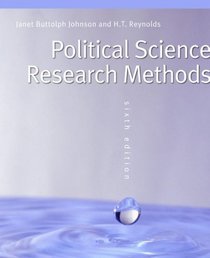Search -
Political Science Research Methods
Political Science Research Methods
Author:
Don t let an introduction to research methods be your students least favorite (and most intimidating) political science course. Relevant, timely, insightful, comprehensive, and always mindful of their student audience, the authors have revamped their popular text so that the sixth edition is friendlier and more intuitive than ever the perfect g... more »
Author:
Don t let an introduction to research methods be your students least favorite (and most intimidating) political science course. Relevant, timely, insightful, comprehensive, and always mindful of their student audience, the authors have revamped their popular text so that the sixth edition is friendlier and more intuitive than ever the perfect g... more »
ISBN-13: 9780872894426
ISBN-10: 0872894428
Publication Date: 12/12/2007
Pages: 613
Edition: 6th
Rating: ?
ISBN-10: 0872894428
Publication Date: 12/12/2007
Pages: 613
Edition: 6th
Rating: ?
0 stars, based on 0 rating
Publisher: CQ Press
Book Type: Paperback
Other Versions: Hardcover
Members Wishing: 0
Reviews: Amazon | Write a Review
Book Type: Paperback
Other Versions: Hardcover
Members Wishing: 0
Reviews: Amazon | Write a Review
Genres:
- Nonfiction >> Philosophy >> Methodology
- Nonfiction >> Politics >> History & Theory
- Nonfiction >> Social Sciences >> Methodology




